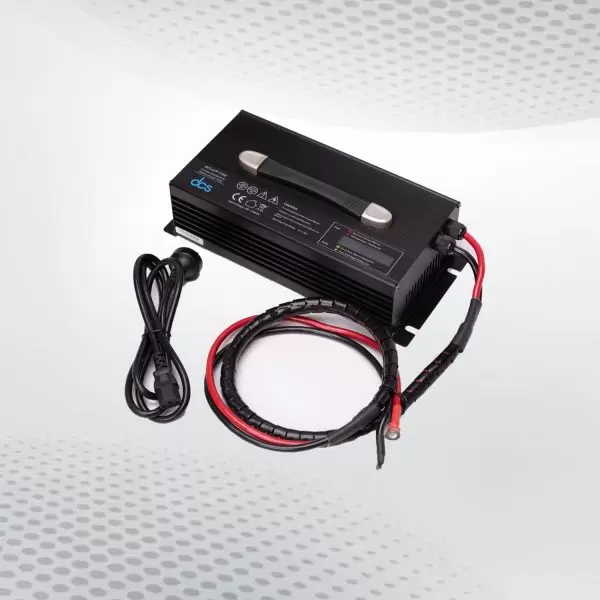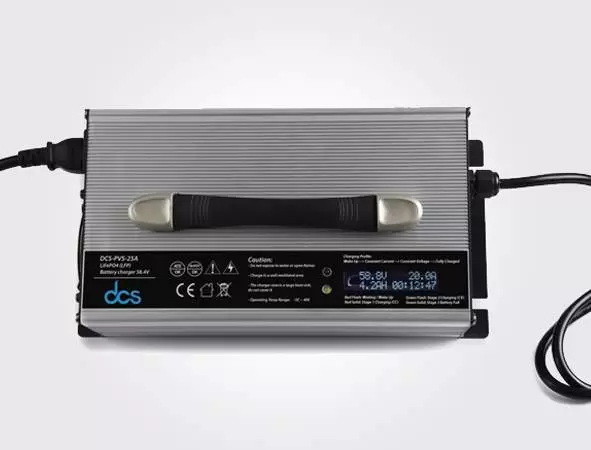Making the right choice for a LiFePO4 battery charger for your application is no small feat. With the variety of models and designs available, it can be hard to determine which will best meet your needs. To help you choose the right LiFePO4 battery chargers for your application, that blog post will provide tips and advice on evaluating the options and making an informed decision. They will eview key features, specifications, and other factors when selecting a LiFePO4 battery charger.
What is a lifepo4 battery, and why do you need a charger?
LiFePO4 batteries, also known as lithium iron phosphate batteries, are a type of rechargeable battery commonly used in various applications, such as electric vehicles, solar energy storage, and portable electronics. These batteries have gained popularity due to their high energy density, long cycle life, and safety features. However, you need a LiFePO4 battery charger to use these batteries efficiently. A LiFePO4 battery charger is a device that charges a LiFePO4 battery safely and efficiently. Unlike other types of lithium batteries, LiFePO4 batteries require a specific charging method and voltage range.
Types of lifepo 4 Battery Chargers
There are a few LiFePO 4 battery chargers to choose from, each with its advantages and disadvantages. The three most common types are:
- Basic Chargers: These chargers are the simplest and most affordable options. They usually have a fixed voltage and current output, which may not be optimal for all battery types.
- Multi-Stage Chargers: These are more sophisticated and offer more precise control over the charging process. They typically use a three-stage charging algorithm that optimizes the charge rate based on the battery’s voltage and temperature.
- Solar Chargers: These chargers use solar panels to convert sunlight into electricity to charge the battery. They are ideal for outdoor and off-grid applications but may not be as efficient as plug-in chargers.
 Voltage and Current Ratings of the Charger
Voltage and Current Ratings of the Charger
When selecting a LiFePO4 battery charger, it’s paying attention to its voltage, and current ratings is important. The voltage rating indicates the amount of electrical pressure the charger can apply to the battery, while the current rating represents the amount of electric current it can supply. The voltage rating of a charger should always match the voltage of the battery being charged. LiFePO4 batteries have a nominal voltage of 3.2 volts per cell, so a 12-volt LiFePO4 battery typically has four cells in series. That means the charger should be rated at 12.8 volts. Using a charger with a different voltage rating can damage the battery or result in an incomplete charge.
The higher the current rating, the faster the battery will charge
The current rating of the charger determines how fast the battery will charge. The higher the current rating, the faster the battery will charge. However, it’s important to note that charging a battery too quickly can cause it to overheat, reducing capacity or even causing permanent damage. The optimal charging current depends on the battery capacity and the charger’s maximum current output. A general rule of thumb is choosing a charger with a maximum current output of no more than 1/10th the battery’s capacity. In addition to the voltage and current ratings, it’s important to consider the charger’s maximum charging power. The power rating is calculated by multiplying the voltage and current ratings, indicating how much power the charger can deliver to the battery.
Charge time
The charge time is another important factor to consider when choosing a LiFePO4 battery charger. That is how long it takes for the charger to fully charge the battery. Generally, the charge time depends on the charger’s current rating, measured in amps (A), and the battery’s capacity, measured in ampere-hours (Ah). A higher current rating means the charger can supply more power to the battery, resulting in faster charge times. However, it’s important to note that charging too quickly can reduce the battery’s lifespan, so choosing a charger that balances charging speed and battery health is important.
Usage of patterns
Charge time can also depend on the charging mode of the charger. For example, some chargers have a “fast charge” mode, which can charge the battery quickly but may not be as gentle as a slower, more gradual charge. Other chargers may have a “trickle charge” mode, which charges the battery slowly and gently over a longer period. When considering charge time, it’s important to factor in your specific needs and usage patterns. If you need a quick charge for emergencies, a fast-charging charger may be more suitable. However, if you’re looking for a charger that can provide a slower and more gentle charge to extend the life of your battery, then a trickle charger may be the better choice.
Charging Modes of 12v lithium battery charger
When looking for a LiFePO4 battery charger, it is important to consider the available charging modes. These charging modes dictate the charging process and ensure the battery is charged efficiently and safely. The following are some of the common charging modes found in 12v lithium battery charger:
- Constant current mode (CC):
That charging mode delivers a constant current to the battery until it reaches a predetermined voltage level. It is commonly used for charging batteries with low initial charge levels.
- Constant voltage mode (CV):
That charging mode delivers a constant voltage to the battery until it reaches its maximum charge capacity. It is commonly used for fully charged batteries that need a top-up charge.
- Trickle charging mode:
That charging mode maintains the battery’s charge level after it has been fully charged. It delivers a low-level charge to the battery to prevent self-discharge.
Pulse charging mode:
That charging mode uses a combination of CC and CV charging modes to provide a high-current charge at the beginning of the charging cycle and then switches to a lower current towards the end. That charging mode helps to prevent overcharging and reduces the charging time. That charging mode uses advanced algorithms to analyze the battery’s charging status and adjust the charging process accordingly. It optimizes the charging process to maximize the battery’s performance and lifespan. It is important to note that not all LiFePO 4 battery chargers offer all these charging modes. When selecting a charger, choose one that offers the appropriate charging modes for your specific application.
Portability and Durability
When choosing a LiFePO4 battery charger, portability and durability are also important factors. If you are someone who frequently travels with your LiFePO4 batteries, then you may want to look for a charger that is compact, lightweight, and easy to carry around. Additionally, the charger should withstand frequent use and transportation wear and tear. That is where durability comes into play. A charger with a sturdy build and quality materials can last years without requiring maintenance or replacement. Some LiFePO 4 battery chargers come with a carrying case or protective cover to protect them from damage during transportation. That can be particularly useful if you use the charger outdoors or in harsh weather.
12v lifepo4 Safety Features
Safety is a top priority when handle 12v lifepo4, and choosing a charger with the appropriate safety features is essential. The following safety features should be considered:
- Overcharge Protection: A good charger must have overcharge protection to prevent overcharging and damage to the battery.
- Short Circuit Protection: The charger should have short circuit protection to prevent short circuits, which can lead to fires and explosions.
- Reverse Polarity Protection: That feature ensures the charger will not function if the positive and negative terminals are connected incorrectly.
- Temperature Control: LiFePO4 batteries can become very hot during charging, so temperature control is essential to prevent overheating and potential damage.
- Automatic Shut-Off: That feature automatically turns off the charger once the battery is fully charged to prevent overcharging and damage.
Compatibility with Different Devices
When selecting a LiFePO4 battery charger, it’s essential to consider compatibility with different devices. Not all chargers are suitable for charging all devices, so it is choosing one compatible with the specific device you want to charge is crucial. Some chargers come with different tips or connectors to fit various devices, while others are designed to work with specific devices. Before purchasing a charger, ensuring it will work with your device is essential. Check the specifications of your device to see what type of charger is recommended. For instance, some devices may require a charger with a specific voltage or current rating. Moreover, it’s important to consider the type of device you’ll be charging.
Price and Warranty
As with any purchase, price is important when choosing a LiFePO4 battery charger. While choosing the cheapest option available may be tempting, it’s important to remember that you get what you pay for. A high-quality LiFePO4 battery charger may cost more upfront, but it will save you money in the long run by preserving the life of your battery and preventing damage from overcharging. In addition to price, it’s important to consider the warranty that comes with your charger. A good warranty will protect you from any defects or malfunctions with your charger, giving you peace of mind knowing that your investment is protected. When shopping for a LiFePO4 battery charger, compare prices and warranties from different manufacturers to find the best value for your money.
Conclusion
Choosing the best LiFePO4 battery charger for your needs can seem overwhelming, but it’s important to take the time to carefully consider your options. Ultimately, your choice will depend on your needs, preferences, and budget. Make sure to select a charger with the appropriate voltage and current ratings for your battery, and take note of the included charging modes and safety features. Don’t forget to consider the portability and durability of the charger, especially if you plan to take it with you on the go. Finally, be sure to choose a charger compatible with the devices you plan to use, with a warranty for added peace of mind.
| Other Good Articles to Read |
| Blogs Rain |
| Cme Blog Spot |
| Garcias Blogs |
| Yyc Blogs |
| Guiade Blogs |
| Blogs-Hunt |
| Impact-Blog |
| Smarty Blogs |
| Ed Blog |
| Mo Blogs |
| Blogs Em |
| Blogs T |

